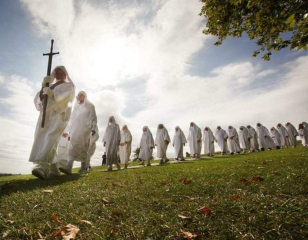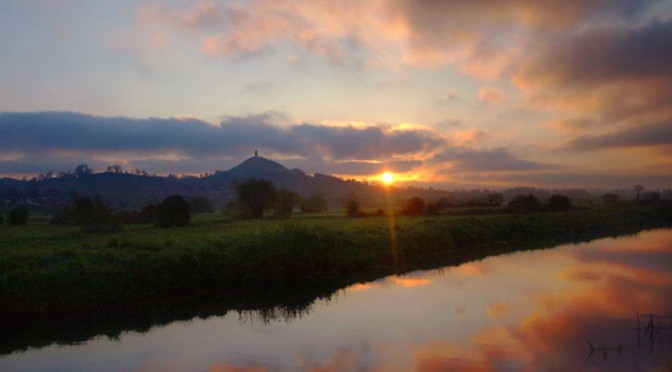The First Church
The church at Glastonbury in Britain is reputed to have been the first christian church above ground . It was built before 50AD but it might well have coincided with the Roman invasion. This introduces the concept of Claudius or his army bringing a new religion to Britain.
Celtic Society
Celtic society was and remained under the new religion Matriachal. A woman normally stayed with her own family for her whole life. However at her choice she could travel or even become a warrior. She could take her pick of the young men and choose wether she had children by them. As one Celtic lady famously said “ it is better that I consort publicly and with joy with all the best men, than to consort privately and in shame with all the worst”.
Whitby
We have little detail of what the Celtic Church actually believed but there certainly were great differences. According to Roman tradition the argument as to wether the Celtic Rite or the Roman Rite should prevail was ended at the synod of Whitby in 663. Roman tradition also says that it was that it was about setting the date for Easter and they way in which monks cut their hair but it was actually about far more important matters. St Augustine, who set about converting the Saxons of SE England in 597 described the Celtic beliefs as “wicked, evil, lewd and corrupt”. Can such a comment be directed at those who choose a different date for Easter?
Pelegarius”]
Many of the differences which brought the Celtic Church in direct conflict with the Roman Church.
One is very well documented. Pelegarius taught that humans are not inherently evil, therefore individuals we are not predisposed to need redemption, that there is no such thing as original sin. He taught that humans do not need the intervention of church or clerics to achieve a higher state, they are capable of reaching a higher state by virtue of their own thoughts and actions. These concepts were formally rejected by the Roman Church and Pelegarius declared a heretic.
Iona v Rome
Unabashed, the Celtic church then sent missionaries and founded monasteries in mainland Europe. The fount of the Celtic Faith was at Iona but we know from oblique references that the Celtic Rite was practiced in Western France, in Germany, Austria and as far as the Ukraine. Though the progression of the Celtic missionaries is well documented there are few names given. One of the few well documented names is Boniface, who was a missionary to Northern Germany. Thus across Europe at this time there were three quite different churches, Arian, Celtic and Roman. As there is no evidence of any convict between members of Arian and Celtic communities they either co-existed and shared beliefs or they were in fact the same religion.
Augustine
 The Church of Rome encouraged or even supported the Anglo Saxon expansion into the Roman Province of Brittania. Why would it do this? Because the Romano celtic inhabitants of Brittania had been Christians for 500 years but it was a different for of christianity than that practised and evangelised from RomeThe Church of Rome encouraged or even supported pagan Anglo Saxon expansion into the Roman Province of Brittania..It was then possible to convert “The Pagan” Anglo Saxons to Roman Christianity taking up the period 597 -664. The spiritual leader was Augustine.
The Church of Rome encouraged or even supported the Anglo Saxon expansion into the Roman Province of Brittania. Why would it do this? Because the Romano celtic inhabitants of Brittania had been Christians for 500 years but it was a different for of christianity than that practised and evangelised from RomeThe Church of Rome encouraged or even supported pagan Anglo Saxon expansion into the Roman Province of Brittania..It was then possible to convert “The Pagan” Anglo Saxons to Roman Christianity taking up the period 597 -664. The spiritual leader was Augustine.
The Celtic bishops would not recognise Augustine as their archbishop, Whereupon Augustine, is said to have answered with a threat that was also a prophecy, that if they refused to preach to the English the way of life, they would eventually suffer at their hands the penalty of death.
The Battle of Chester
Despite this threat in the old Romano-Celtic kingdoms, Strathclyde, Rheged, Wales Mercia and Cornwall the celtic version of christianity survived.The Roman Church church to the spread of religion by conquest.
Legend has it that King Aethelfrith of Northumbria defeated the Mercians and their Welsh allies in a bloody battle at Heronbridge, near the banks of the River Dee, and next to Handbridge. Nearly 1,200 monks are said to have been killed during the clash. Heronbridge is now a suburb of the City of Chester.
The venerable Bede, an Anglo-Saxon chronicler and theologian, recorded that the monks were from nearby Bangor-on-Dee monastery who had come to Chester to pray and chant and were slaughtered by King Aethelfrith, who believed praying against him was as bad as fighting against him. The monastery was also subsequently destroyed.
The Fringes
Following the battle, the Welsh were cut off from their compatriots in Cumbria and Cornwall, and the history of Wales as a separate nation can said to date from this time and this battle.
After the Synod Of Whitby those who adhered to the Celtic rite supposedly retreated to the “fringes of the Christian world”. In England that meant Wales Scotland and Ireland! In Europe that meant the Southern Atlantic Seaboard, the Central Massif, below the Garonne and the high alps of Provence’ in other words Occitan!
Further conflict
However the reason the Pope supported William of Normandy in his conquest of the British Isles in 1066 was to finally eradicate the Celtic “heresies” That did not work either! He tried again with Henry II giving him preference over Steven of Blois on condition that Henry imposed the Roman faith on Ireland. All this was only the aperitif for the Prussian and Albigensian Crusades!
